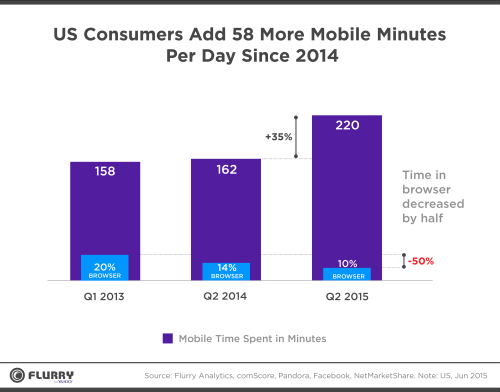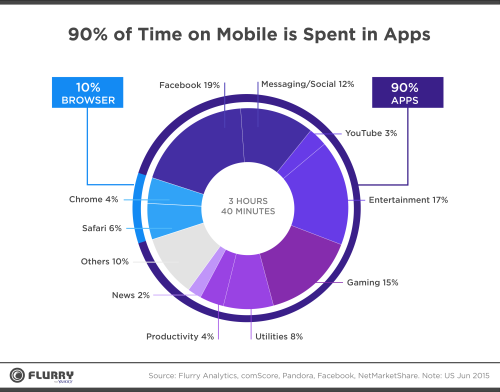Last week, Marketing Land published an article with statistics around mobile browser usage. According to the article, people are spending more time than ever on their mobile phones. More than likely if you are anything like me you don’t need a think-tank to tell you this fact. It turns out that the time spent using apps has grown to 90% while browser time has declined to 10%. Again this data is no surprise. The data referenced in the article came from a talk that was given by Yahoo’s Simon Khaaf at the Mobile Developer Conference in New York. So trust me, it is legit, or trust Yahoo.

This post will cover my view on the consequences this data has for the paid search industry.
Here at PPC Hero, our paid search work encompasses any type of paid digital advertising. This means we manage accounts in search engines, display networks, and various social platforms such as Facebook, Twitter, LinkedIn, YouTube and more. Facebook, Twitter, LinkedIn and YouTube are all accessed on mobile devices through apps. If you access these websites using the browser on your phone, you are losing out on many real-time alerts, messages, and red numbers.
As Jake wrote in his post “There Is No Perfect Keyword“…”Search is so great because it is so targeted.” But seriously, it is an easy sell for most companies that want to make money. The ads are timely, easy to measure and justifiable as a marketing expense. You buy a keyword, people click, and then buy your product or service. Unfortunately, Google and Bing are on to us. Buying ads is expensive and based on the data in the Marketing Land article, there is less search volume on mobile since users are on Facebook, Instagram, and Twitter posting selfies, meaningful quotes and thoughts. So what can be done? And how can we be responsive and proactive in our marketing approach?
We follow the masses and learn to show ads where people play. And we make our ads look so great that people can’t help but click. We entice.
Here is more proof of what the person sitting next to you is doing on their phone. The person who is on their phone looking otherwise engaged probably spends 3 hours and 40 minutes a day with 19% of that time spent on Facebook, 12% spent on Messaging/Social and the rest on YouTube and consuming other entertainment apps – Pinterest anyone?

But wait? Now that we know people are on Facebook and other social sites as well as messaging and watching videos on their phones, how do we use that knowledge to change the way we approach PPC?
We allocate spend differently – How many keywords do you have in your account that are not performing as well as they could? These keywords could be generating clicks and possibly assisting in conversions, however, because search is driven by intent the tendency is to maintain the existing keyword footprint. This intent is still a calculated guess. Furthermore, the CPCs in Google and Bing are known to be significantly higher.
We segment keywords differently – Taking a holistic view of all your keywords is a great strategy checkpoint. Using social media advertising you can leverage a funnel approach easily. In fact, a funnel approach is easier on social media because you are able to design ads with pictures as well as more content. Pictures and text are great ways to convey emotion and how brands fit lifestyles.
Of course, pulling your assisting keywords and moving budget over to the social channels can be a radical change. However, did you know that capturing a lead via Facebook is much easier than capturing a lead on your website? Lead ads make the mobile sign up process easier by automatically populating contact information that people have given Facebook, like email addresses.
Lastly, the targeting options for social advertisers are outstanding. Users can be targeted or excluded based on specific pages that have been visited on your website. This means as an ecommerce client offering multiple products you can tailor your ads based on customer micro-interest. Advertisers can also pay to advertise a product based on related content that was consumed. If someone reads this article on PPC Hero our agency can advertise PPC services for the following week. Then as an agency we can measure the direct revenue to each account manager based on business-driven after reading PPC Hero. Ads can be targeted to job titles, industry, marital status and more.
Fundamentally, the shift into social advertising is simply one of targeting interests versus targeting by intent, but as we know the intent of searchers is not a 100% guarantee of success.
Additional Considerations
- How you bucket your audience – When a user visits our website or likes your page you can segment those users and market to them differently than you would a user with less engagement. If ads show products or services related to past engagement the chances of conversion increase.
- Technology Process and Infrastructure – In order to build conversion data and segment users, tags need to be placed on the website. These tags are easy to place but at times they need troubleshooting and working with an agile development team can mean better measurement and more targeted ads as a result.
- A deep understanding of your current and potential customers – The more understanding you have around who and where your customers spend time the better you can target and design ads. All too often business to business clients discount social advertising and fail to understand that users are on Facebook during business hours or interacting on Twitter with others in the industry, and certainly using LinkedIn to connect with business contacts.
- Use native advertising – Native advertising is best described as ads that blend in with the user experience. Mobile phones are smaller than computers so the creative team should follow design principals that align with the brand but do not hinder the viewing experience. Following these design principals will result in a higher click-thru rate.
- Focus on Data – Companies with shared logins such as Facebook can market to individuals across devices with precision, however, there are third-party technology companies that are helping companies bridge this gap since some of the tagging and technology can be challenging. Continuing to maintain organizational focus on the use of data for decisions will help when designing ad campaigns.
Conclusion
It is easy to see how a client might be hesitant to place ads outside the Search Network as for most advertisers sales are the primary goal. However, using the right creative and following best practices can make the ads seem natural, integrated and even entertaining, which can lead to incremental conversions.
The data shows users are spending more time interacting with applications and being social instead of web browsing. Social advertising forces us as marketers to move to where people are spending their time. If we can follow the tips provided in this post, our ads will be relevant, timely and align with our ideal customers. Ads will address needs and wants and pull in the click while potential customers are leisurely scrolling through their feeds. People are liking, retweeting, reposting, double tapping and commenting in the social sphere. The data shows we all love to stalk while waiting in line or killing time or simply tuning out the world around us. As General George Patton once said, “We herd sheep, we drive cattle, we lead people. Lead me, follow me, or get out of my way”.



